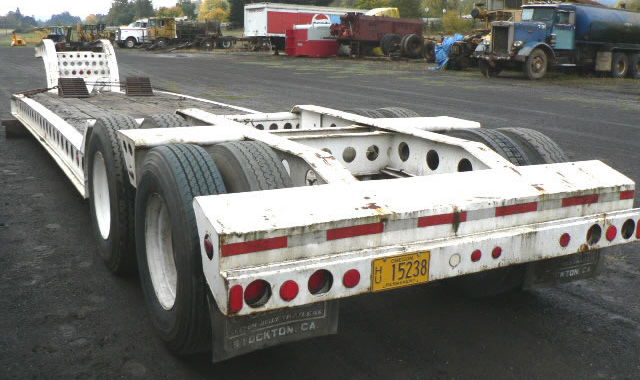Lowboys (Download)
Lowboy Trailers 1 Lowboy Trailers A lowboy is a type of trailer that is used for moving heavy equipment and other large loads. The term “lowboy” refers to the height of the deck of the trailer. The object being transported rides on a lowered deck, instead of above the wheels as with a traditional trailer. This allows very tall loads to be transported legally. 2 Lowboy History The first lowboy trailer was invented in the 1920s and featured a riveted gooseneck and solid rubber tires. The first detachable (front-loading) gooseneck trailer was invented in 1958. 3 Types of Lowboys Rear Loading Front Loading 4 Lowboy Uses Transporting construction equipment such as bulldozers, track hoes, crane components, and loaders Transporting other equipment such as air conditioners, industrial equipment, and crushers Done Right Transportation 5 Lowboy Safety The majority of the major safety concerns are related to the loading and unloading of the trailer. The machinery may become unstable and slide or roll off of the trailer. This is particularly true if the machine has metal tracks that have very little traction on the metal deck of the trailer, or if loading/unloading is attempted on a sloped grade. 6 Typical Hazards Pinch Points Loading and Unloading Construction Equipment Crushing Hazards Operator Errors 7 Lowboy Fatalities E xtracted from OSHA construction worker fatality data (1990-2007) 42 Total OSHA Fatalities Investigated from 1990 thru 2007. 8 Fatality Example An operator was unloading a dozer off a tilt lowboy trailer when the tractor slid off the trailer. The tractor was equipped with rops but was not equipped with seat belts. The operator jumped off the low side in an attempt to avoid the sliding dozer, but the rops pinned and crushed him at the abdomen. He died from his injuries. 9 Fatality Example An operator was unloading a backhoe from a lowboy trailer. Four other people were standing on the ground, watching the operation. One of them, an oiler, was helping the operator stay clear of a 14.4-kilovolt overhead power line. In spite of this, the boom contacted the power line, and one of the employees on the ground (a pipe line welder) was electrocuted. The other three persons did not receive electric shocks. 10 Fatality Example Two workers were directing a driver in the positioning of a lowboy trailer. A generator and a road-header were to be offloaded. The lowboy was being backed up the inside lane of a two-lane access road that was bordered on the inside by articulated concrete barriers and outside by traffic cones or the equivalent. One worker was walking in the inside lane facing the direction in which the lowboy was backing up, and was in verbal and visual contact with the signal person, who was walking beside the lowboy on the street side with a flag. The worker was hit and run over by the rear-most dual wheels of the lowboy when the flagman momentarily turned his head toward the driver, who had a limited view of him and his position. 11 Safety Practices Always secure the load on the trailer, even when transporting equipment short distances. When transporting equipment on a lowboy, make sure there is adequate clearance around the equipment so as to not strike nearby workers or vehicles. Make sure the brakes on the lowboy and on the truck pulling the lowboy are properly adjusted. 12 Safety Practices Trailer must be on level ground before loading or unloading If machinery is being loaded or unloaded, be sure that all safety systems are in place, and if equipped with a ROPS, seat belt must be in working order and used. 13 Safety Practices Area around trailer during loading/unloading should be clear of other employees All systems on the trailer should be inspected before each use and kept in proper operating condition 14 THINK Safety Work safely 15

